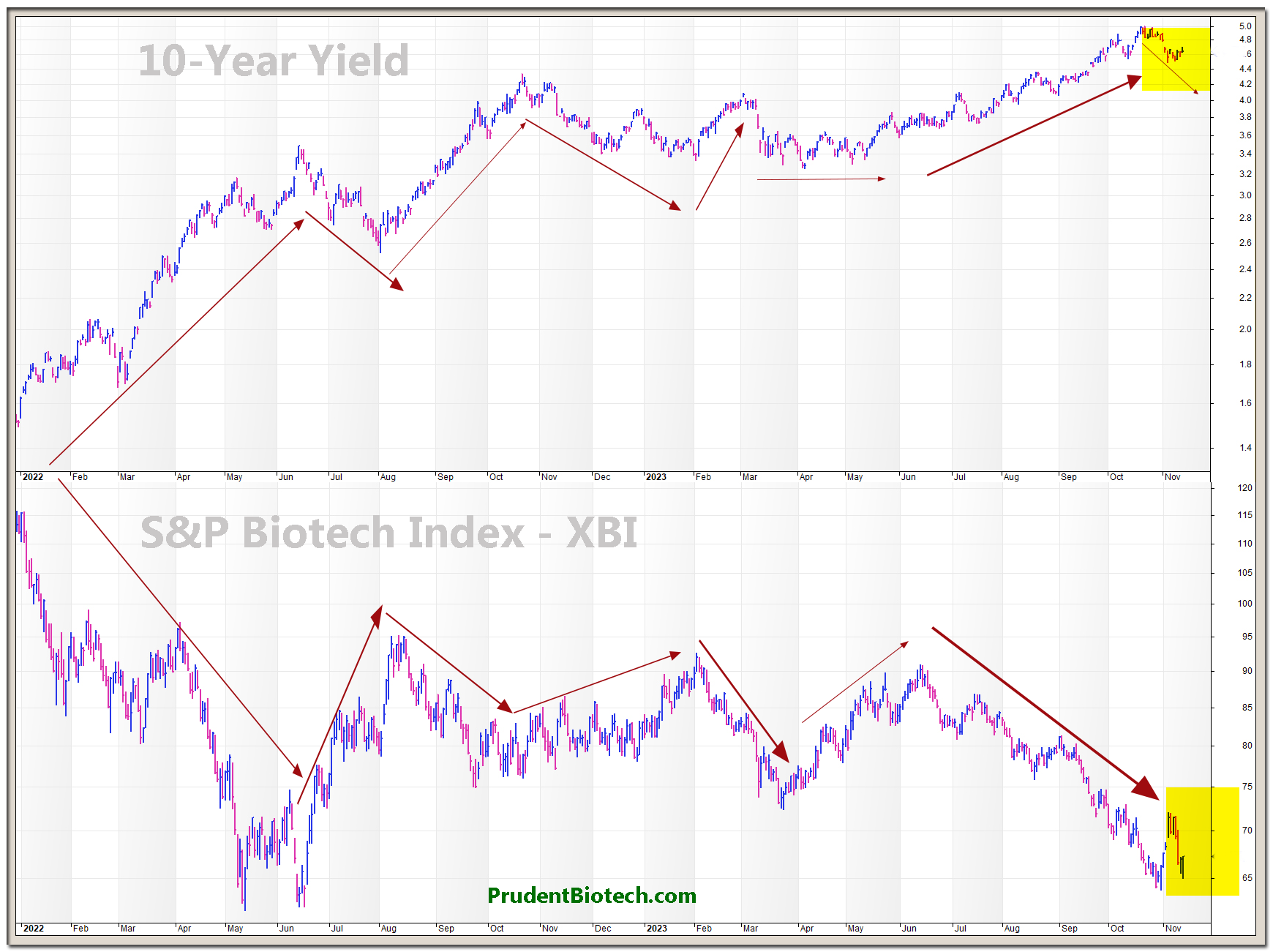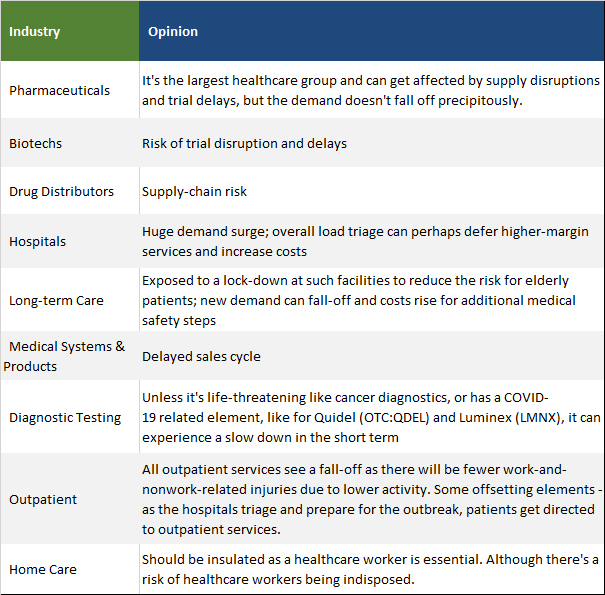
Biotech Pulse
Investing in biotechs in 2023 proved challenging as the burden of a rising 10-year Treasury yield pushed the industry group to new yearly lows. As recently as last October, the industry group was trading at levels seen during March 2020, when the pandemic-related selloff occurred. The biotech industry group started its rebound in November, driven by a decline in the 10-year Treasury yield, which allowed the biotech index to recover its losses and gain a little ground for the year.

In the 2023 biotech outlook, we had projected for the Nasdaq Biotech Index to rise in the high teens, acknowledging the pivotal importance of the 10-year yield and noting that:
"Under the assumption that the 10-year yield will not make new highs this year, we anticipate the biotech group to deliver returns of 15% and perhaps higher during 2023."
However, rising yields throughout the year tested this assumption.
Biotech's Path In 2024
This is the year the Fed Funds rate will begin its descent. A shift in monetary policy from rate hikes to rate cuts is generally positive for the stock market. However, if the rate cuts are mostly a result of a material drop in economic activity, that will pose a serious challenge for many industry groups. For biotechs, lower earnings growth issues should be mitigated and the group is likely to have a standout year.
10-Year Treasury Yield To Favor Biotechs
The direction of the 10-year yield significantly influences biotech performance. As the yield trends lower, it stimulates valuations, removing a hurdle for stocks, particularly biotechs. Stocks can rise even with gradually rising yields when economic growth overcomes the yield penalty. However, investors are likely to encounter a different environment in 2024.
Biotechs were on a slippery slope in 2023 due to the yield on the benchmark 10-year Treasury note surging from ~3% in March to 5% in October. When the yield began to drop last November, biotech valuations remained mired at their lows. It is this divergence that we pointed out in a November article, Biotech Stocks Ready to Roar, recommending a strong exposure to the industry group.
The robust negative correlation between the yield curve's trajectory and the biotech industry's fortunes is presented below. The highlighted section in the image from the last article shows a yield decline with no corresponding gains for the biotech index at that time.
In 2024, the 10-year yield is likely to be more supportive of biotech valuations, notwithstanding occasional and transitory yield spikes, and it should settle below 4%. Yields don't have to keep falling for biotech stocks to outperform. Even stabilizing at the present lower levels will diminish concerns and allow trial results and pipeline prospects to drive biotech valuations.
With the Fed expressing its intent to align its restrictive policy to reflect real rates, there appear to be more reasons for yields to trend lower than higher at this time. Nonetheless, forecasting yield is a hazardous task and the risk must be monitored.
Pushing the Frontiers in Medical Science
There is notable progress being achieved as biotech and pharmaceutical companies move forward to deliver some ground-breaking treatments.
Weight Loss Drugs
One such treatment is the glucagon-like peptide 1 (GLP-1), also referred to as gut hormone, weight loss class of drugs.
Novo Nordisk's (NVO) drug, Ozempic, and Eli Lilly's (LLY) drug, Mounjaro, are presently the only approved GLP-1 weight loss treatments targeting the mass market. Last month, Pfizer (PFE) announced that it will abandon developing its twice-daily version of the weight loss pill Danuglipron due to tolerability issues, although it still plans to release Phase 2 data in the second quarter on its daily version of the drug. Merck (MRK) has development efforts in this segment with its experimental drug Efinopegdutide, which is being targeted for patients with a progressive liver disease called nonalcoholic steatohepatitis, or NASH, but has potential as a weight loss drug.
There are quite a few biotechs with approved or development-stage weight loss drugs, including Rhythm Pharmaceuticals (RYTM) which received approval for its drug Imcivree in 2022, Soleno Therapeutics (SLNO), and Altimmune (ALT). Pfizer recently estimated that the market opportunity for weight loss drugs could surge to $90 billion and the company would target 10% of it.
Neurology
There is tangible progress in managing Alzheimer's disease, which afflicts over 7 million Americans. However, the road to an effective treatment is long.
In January 2023, the drug Leqembi from Eisai and Biogen (BIIB) was approved by the FDA in an accelerated approval. It showed a slower decline in cognitive function in cases of mild cognitive impairment due to Alzheimer's disease. In October 2023, Eisai reported further progress with an injectable version of Leqembi which showed more efficacy in an early-stage clinical trial, removing 14% more plaque than the approved intravenous formulation. If approved in a few years, the injectable version will make it much easier to administer the drug and further expand the market.
There was further progress on the Alzheimer's front when Eli Lilly reported in July 2023 that its drug Donanemab, which works on the same amyloid beta reduction hypothesis as Leqembi, significantly slowed cognitive decline in people living with mild cognitive impairment or mild dementia. The drug is expected to receive FDA approval in the first quarter of 2024, which would add to Eli Lilly's recent success in developing blockbuster drugs.
Above is an actual image of the visual cortex of a person with Alzheimer’s disease. The giant blue web is depicting brain cells called astrocytes, which typically help form and protect the brain’s connections. Based on advancing research and a recent set of images, including this one, it appears that astrocytes can engulf and attack the brain’s synapses (shown here as fluorescent dots), which contributes to the deterioration of the mind. Researchers with the Brain Atlas, a project that began in 2017, have identified some 3,300 types of brain cells or neurons and have only a dim notion of the function of most of these cells. Identifying the functionally distinct types of neurons, which are the elementary computational elements that collectively create the brain, is critical to an understanding of how the brain works. The path remains long and challenging.
Neuroscience research is a focus for many companies, including Karuna Therapeutics (KRTX), Neurocrine Biosciences (NBIX), Ionis Pharmaceuticals (IONS), Intra-Cellular Therapies (ITCI), Axsome Therapeutics (AXSM), Prothena (PRTA), and Cassava Sciences (SAVA).
Oncology
Oncology remains the largest market opportunity and one that receives the most research funding from pharmaceutical and biotech companies. There has been continued progress on CAR-T and allogeneic therapies.
One area of groundbreaking progress is cancer vaccines. Merck (MRK) and Moderna (MRNA) have been combining their respective expertise in immuno-oncology and mRNA technology in developing cancer vaccines. After promising data in 2022, the companies built further on the progress, and a few weeks ago reported highly favorable data from a Phase 2b trial, with the combination of the vaccine and Keytruda reducing the risk of recurrence or death by 49% and the risk of distant metastasis or death by 62%, compared to Keytruda alone, in stage III/IV melanoma patients with high risk of recurrence following complete resection. The companies have also initiated a Phase 3 trial in non-small cell lung cancer and plan to expand the development program to additional tumor types.
Cancer vaccines are coming and will expand the options for patients to combat cancer.
Gene Editing
Gene editing treatments are advancing into approved therapies, highlighting the effectiveness of the approach to deliver targeted and transformative treatments, especially for patients with rare diseases that have limited treatment options. Last month, the FDA approved a groundbreaking treatment for sickle cell disease, the first such approval of a treatment using CRISPR gene editing technique. The treatment was co-developed by Crispr Therapeutics (CRSP), using its gene-editing technology, and Vertex Pharmaceuticals (VRTX). Management consulting firm McKinsey estimates that 30 new cell and gene therapies can come to market in 2024, up from 1 in 2023.
The cornucopia of platform-driven approaches from RNA to gene editing to oncology therapies underscores the relentless quest for treatments and the potential for many new drug discoveries during 2024.
M&A and Partnerships
In our November update to Prudent Biotech members, we noted that the realization that interest rates have likely peaked will indicate that biotech valuations have bottomed out and thus, should spur biotech acquisition activity.
Last December was the busiest transaction month for 2023 with six transactions worth more than $40 billion. The largest of these was the acquisition of Karuna Therapeutics for $14 billion by Bristol Myers Squibb (BMY), and two acquisitions by AbbVie (ABBV) of Cerevel Therapeutics (CERE) and Immunogen (IMGN) for a combined $19 billion. Neuroscience and oncology specialties dominated the transactions during December.
We believe the timing seems highly favorable for a strong M&A year and 2024 activity has the potential to be the strongest in recent memory. With significant pressure on pharmaceuticals and large biotechnology companies to grow pipelines, the existing low relative return on in-house R&D of pharmaceutical companies, and a shift in the interest rate trend signaling a bottom for biotech valuations, there is little reason for large biopharmas to wait.
Drug Price Regulation
A prominent risk for the pharmaceutical and biotech industry groups is the conflict around drug price regulation.
As part of the Inflation Reduction Act, the Center for Medicare & Medicaid Services (CMS) acquired the authority to negotiate prices for Medicare in 2024. The process started last year with the identification of 10 drugs to be negotiated in the first round, and the actual price negotiation will begin on February 1 when CMS offers its initial “maximum price” for these drugs. After a window for negotiations with the drug manufacturers, the CMS will make its final price offer on July 15. If the drug manufacturer does not accept then they will have to pay a steep excise tax on US sales of that drug or withdraw from Medicare and Medicaid coverage. The pharma industry is fighting the issue in the courts and decisions are likely to start coming by mid-year.
The drug price negotiation is the first time the industry has faced such a forceful challenge on high drug prices, and it can lead to lower prices, lower revenues, and lower profit margins for the industry. The issue has cast a long shadow on pharmaceuticals but is unlikely to adversely impact M&A valuations for small-to-mid-sized biotechs.
Conclusion
The biotechnology industry appears to be well positioned to outperform the broader indexes in 2024, provided the 10-year yield remains below 4%. It will not be surprising for the 10-year yield to spike in some months. However, the trend for yields during 2024 is very likely to be a downward one and should be reassuring for biotech investors.
A big risk for the stock market is a slower timetable for rate cuts pursued by the Fed, who may decide to walk back the aggressive market expectations. A decision from the next Fed meeting will be announced on January 31. There could be potential headwinds including a slowdown in earnings growth perhaps as early as the upcoming earnings season beginning mid-January. There are also uncertainties related to a Presidential election year, typically favorable for stocks but raises the risk in the months immediately preceding the election, the inability of the House thus far to pass a government funding bill with the next deadline of January 19, and global geopolitical risks. The stock market is heavily overbought presently and is likely to experience a natural pullback shortly.
Biotechs have been consolidating in a range for two years. That period of consolidation cannot be underestimated and can prove to be a springboard as market conditions turn favorable, which appears to be happening.
A confluence of low relative valuations, diminishing yield concerns, an improving risk environment, an accelerating pace of M&A, industry group rotation in case of economic concerns, and a lengthy consolidation period, all position the biotech group for a forceful advance during 2024. We estimate biotech indexes are positioned to deliver returns of 20% to 25%, and likely even higher, in 2024.
With the overarching trends shifting in favor of biotechnology, there are many promising companies that can outperform in 2024. A few of these, which may already be part of the Prudent Biotech, the Prudent Healthcare, and the Prudent Small Cap model portfolios, include Vertex Pharmaceuticals (VRTX), Moderna (MRNA), Blueprint Medicines (BPMC), BridgeBio Pharma (BBIO), Acadia Pharmaceuticals (ACAD), Rhythm Pharmaceuticals (RYTM), Neurocrine Biosciences (NBIX), Apellis Pharmaceuticals (APLS), Intracellular Therapies (ITCI), Immunovant (IMVT), BioNTech (BNTX), Ideaya Biosciences (IDYA), Axsome Therapeutics (AXSM), Nuvalent (NUVL), Cymabay Therapeutics (CBAY), Soleno Therapeutics (SLNO), Madrigal Pharmaceuticals (MDGL), ALX Oncology (ALXO), and Crinetics Pharmaceuticals (CRNX).
A major industry event this month is the J.P. Morgan Healthcare Conference from January 8-11. It is the largest healthcare investment symposium providing industry insights and setting the healthcare investment tone for the year. It is often used as a platform for corporate news releases including trial results and M&A.
This outlook expectation is simply a general framework to guide investors about the potential and will need to be adjusted if market conditions deviate materially from current expectations.
The article was submitted on Jan 2 for publishing first on Seeking Alpha.


